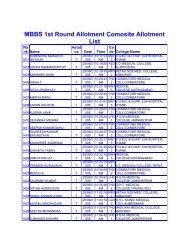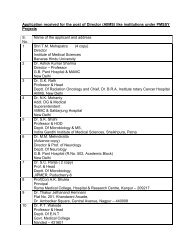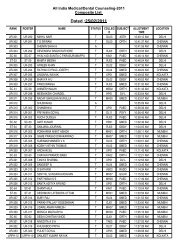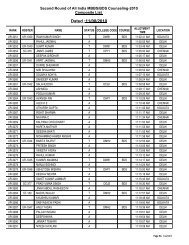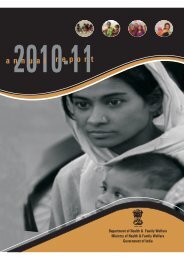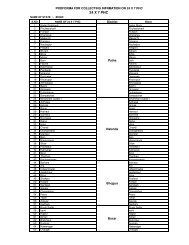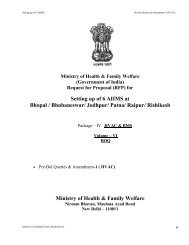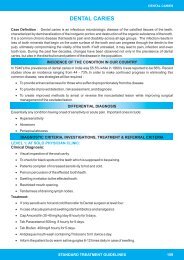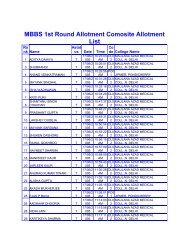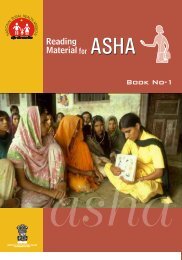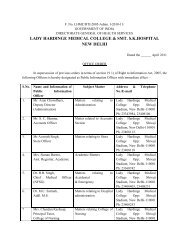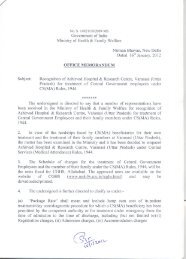National Vaccine Policy Book - Ministry of Health and Family Welfare
National Vaccine Policy Book - Ministry of Health and Family Welfare
National Vaccine Policy Book - Ministry of Health and Family Welfare
You also want an ePaper? Increase the reach of your titles
YUMPU automatically turns print PDFs into web optimized ePapers that Google loves.
For almost 2 decades since the beginning <strong>of</strong> UIP, India had same 6<br />
antigens in the UIP <strong>and</strong> recently Hepatitis B <strong>and</strong> measles second<br />
dose has been incorporated in UIP. There are a number <strong>of</strong> diseases,<br />
for which vaccines exists for long (Typhoid, Rubella), which may<br />
further be considered for the introduction in NIP in India. Similarly, a<br />
number <strong>of</strong> new vaccines have become available in last few years.<br />
Haemophilus influenzae type b (Hib) vaccines, Pneumococcal<br />
conjugate vaccines, Rotavirus vaccines, HPV vaccines, which have<br />
estimated high burden <strong>and</strong> possible role in reducing child mortality in<br />
India.<br />
One <strong>of</strong> the major hurdle in the decision making process for the<br />
introduction <strong>of</strong> new vaccine has been the lack <strong>of</strong> indigenous<br />
surveillance data to assess the disease burden. The country need to<br />
build upon the available investigator initiated research, modeling<br />
data, <strong>and</strong> systematic reviews to assess the disease burden.<br />
Nonetheless, the efforts should be made to strengthen VPD<br />
surveillance system. The institutional capacity building should be<br />
done for conducting demonstration projects <strong>and</strong> impact studies in<br />
the country.<br />
3.2. Barriers to strengthen Immunization Programme<br />
There are well recognized challenges in the implementation <strong>of</strong><br />
immunization program in the country. These challenges are:<br />
• Weak VPD surveillance system;<br />
• Lack <strong>of</strong> data on disease burden in India <strong>and</strong> resulting perception<br />
that the disease is not important public health problem;<br />
• Lack <strong>of</strong> diagnostic tools for certain vaccine preventable diseases<br />
that could be used without sophisticated instruments or<br />
specialized training;<br />
• Lack <strong>of</strong> baseline surveillance data also is a bottleneck in<br />
monitoring the impact <strong>of</strong> vaccination;<br />
• Limited economic evaluations to show cost effectiveness <strong>of</strong><br />
vaccines over other interventions to support decision-making;<br />
• Lack <strong>of</strong> a financial sustainability plan for the introduction <strong>of</strong> new<br />
vaccines in the UIP also affects decision making in this area.<br />
• Shortage <strong>of</strong> trained manpower to manage the UIP at the Center as<br />
well as State levels, for innovations in vaccines, for disease<br />
surveillance <strong>and</strong> for procurement <strong>and</strong> effective vaccine<br />
management.<br />
These challenges need to be addressed to improve the<br />
Immunization Programme performance in India. This policy<br />
document also aims to provide policy measures to address the<br />
above mentioned barriers.<br />
4. VACCINE RESEARCH AND DEVELOPMENT<br />
The research <strong>and</strong> development (R&D) <strong>and</strong> manufacturing <strong>of</strong><br />
vaccines for locally prevalent diseases in India should be given a<br />
priority. These include vaccines for major killers like pneumonia <strong>and</strong><br />
diarrhea, diseases with potential to cause outbreaks like JE,<br />
Dengue, Cholera, Typhoid <strong>and</strong> diseases like Leishmaniasis etc. The<br />
processes, funding, networks, repositories etc. that would make this<br />
possible are detailed in the following sections.<br />
4.1. Institutional capacity <strong>and</strong> framework<br />
<strong>Vaccine</strong> development is a long, multi stage process where critical<br />
actions must be decided <strong>and</strong> taken in synergy <strong>and</strong> not sequentially.<br />
The R&D <strong>of</strong> vaccines is undertaken in the academia as well as by the<br />
vaccine industry. There are a number <strong>of</strong> challenges faced by the<br />
developing countries in vaccine research.<br />
India has a number <strong>of</strong> institutions, where vaccine related projects are<br />
implemented i.e. Indian Council <strong>of</strong> Medical Research (ICMR),<br />
Department <strong>of</strong> Science <strong>and</strong> Technology (DST), Council for Scientific<br />
<strong>and</strong> Industrial Research (CSIR), small <strong>and</strong> medium vaccine<br />
industries, medical <strong>and</strong> engineering schools, in addition to the<br />
Department <strong>of</strong> Biotechnology (DBT) supported autonomous<br />
institutions.<br />
India’s strong <strong>and</strong> growing vaccine manufacturing sector <strong>and</strong> a<br />
rapidly rising global dem<strong>and</strong> in vaccine R&D is also a tremendous<br />
economic opportunity. A number <strong>of</strong> linkages need to be explored<br />
between academia, industry <strong>and</strong> international institutions such as<br />
NIH/NIAID, Gates Foundation, GAVI Alliance, PATH, WHO <strong>and</strong> the<br />
International Centre for Genetic Engineering <strong>and</strong> Biotechnology<br />
(ICGEB). Areas that require attention include the following:<br />
• A fund for gr<strong>and</strong> challenges in vaccine R&D needs to be created.<br />
This fund to be utilized for R&D <strong>of</strong> country disease burden specific<br />
vaccines,<br />
06 07




